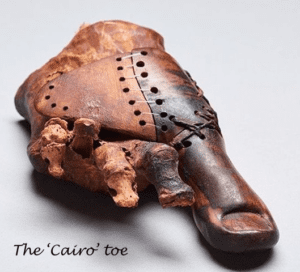JMS Pearce
Hull, England
These common words are sometimes confused.
Orthosis is a term first used in English in 1857, from the Greek ὄρθωσις—“making straight.” It is a device that supports or assists residual function after illness or injury.
Prosthesis is a Latin word derived from the ancient Greek πρόσθεσις, meaning “addition.” Like many words, its meaning or usage has changed with time. Originally, it was the addition of a letter or syllable to the beginning of a word; since 1706, in contrast with orthosis, it has meant an artificial replacement for a defective or absent part of the body.
Splint, Middle English from Dutch splitten and German splinte, is an older word first appearing in English c. 1400 for any rigid material used to hold a fractured or dislocated bone in position. It was also commonly applied to supports for metal or wood in laths, wattle, or constructions; as fragments (splinters) of diamonds and stones; and as a callous excrescence on the metacarpal bones of a horse’s or mule’s leg.
Splints and prostheses have been used for thousands of years. The oldest known example (The Cairo Toe) is a three-part wood and leather toe dating from between 950 to 710 BC, found on a female mummy buried in a tomb at Sheikh Abd el-Qurna, near Luxor.
The Greville Chester artificial toe is from before 600 BC and is made of cartonnage*, a linen gesso mixture. It was uncovered with a mummy in the 1880s. The Greville Chester toe does not bend at any joint and may have been impracticable for prolonged usage. The British Museum purchased it in 1881 from the author, explorer, and collector Rev. Greville John Chester (1830–1892).
Note
* Cartonnage is the general term used in Egyptology for flexible plastered layers of fiber or papyrus moulded while wet against irregular surfaces of the body.
 |
 |
| The Cairo Toe
|
The Greville Chester artificial toe |
JMS PEARCE is a retired neurologist and author with a particular interest in the history of medicine and science.

Leave a Reply